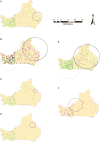Spatial distribution and cluster analysis of risky sexual behaviours and STDs reported by Chinese adults in Guangzhou, China: a representative population-based study
- PMID: 26843400
- PMCID: PMC4874914
- DOI: 10.1136/sextrans-2015-052268
Spatial distribution and cluster analysis of risky sexual behaviours and STDs reported by Chinese adults in Guangzhou, China: a representative population-based study
Abstract
Objectives: To assess associations between residences location, risky sexual behaviours and sexually transmitted diseases (STDs) among adults living in Guangzhou, China.
Methods: Data were obtained from 751 Chinese adults aged 18-59 years in Guangzhou, China, using stratified random sampling by using spatial epidemiological methods. Face-to-face household interviews were conducted to collect self-report data on risky sexual behaviours and diagnosed STDs. Kulldorff's spatial scan statistic was implemented to identify and detect spatial distribution and clusters of risky sexual behaviours and STDs. The presence and location of statistically significant clusters were mapped in the study areas using ArcGIS software.
Results: The prevalence of self-reported risky sexual behaviours was between 5.1% and 50.0%. The self-reported lifetime prevalence of diagnosed STDs was 7.06%. Anal intercourse clustered in an area located along the border within the rural-urban continuum (p=0.001). High rate clusters for alcohol or other drugs using before sex (p=0.008) and migrants who lived in Guangzhou <1 year (p=0.007) overlapped this cluster. Excess cases for unprotected sex (p=0.031) overlapped the cluster for college students (p<0.001). Five of nine (55.6%) students who had sexual experience during the last 12 months located in the cluster of unprotected sex.
Conclusions: Short-term migrants and college students reported greater risky sexual behaviours. Programmes to increase safer sex within these communities to reduce the risk of STDs are warranted in Guangzhou. Spatial analysis identified geographical clusters of risky sexual behaviours, which is critical for optimising surveillance and targeting control measures for these locations in the future.
Keywords: EPIDEMIOLOGY (GENERAL); SEXUAL BEHAVIOUR; SEXUAL HEALTH.
Published by the BMJ Publishing Group Limited. For permission to use (where not already granted under a licence) please go to http://www.bmj.com/company/products-services/rights-and-licensing/
Conflict of interest statement
Figures

Similar articles
-
Social and behavioural factors associated with risky sexual behaviours among university students in nine ASEAN countries: a multi-country cross-sectional study.SAHARA J. 2018 Dec;15(1):71-79. doi: 10.1080/17290376.2018.1503967. SAHARA J. 2018. PMID: 30058474 Free PMC article.
-
Association of MDMA/ecstasy and other substance use with self-reported sexually transmitted diseases among college-aged adults: a national study.Public Health. 2009 Aug;123(8):557-64. doi: 10.1016/j.puhe.2009.06.012. Epub 2009 Aug 4. Public Health. 2009. PMID: 19656538 Free PMC article.
-
Club drug use and associated high-risk sexual behaviour in six provinces in China.Addiction. 2015 Jan;110 Suppl 1:11-9. doi: 10.1111/add.12770. Addiction. 2015. PMID: 25533860
-
A Systematic Review and Meta-Analysis of Epidemiology of Risky Sexual Behaviors in College and University Students in Ethiopia, 2018.J Environ Public Health. 2019 Mar 20;2019:4852130. doi: 10.1155/2019/4852130. eCollection 2019. J Environ Public Health. 2019. PMID: 31015844 Free PMC article.
-
A scoping review of risk behaviour interventions in young men.BMC Public Health. 2014 Sep 16;14:957. doi: 10.1186/1471-2458-14-957. BMC Public Health. 2014. PMID: 25224717 Free PMC article.
Cited by
-
Relationships among impulsive, addictive and sexual tendencies and behaviours: a systematic review of experimental and prospective studies in humans.Philos Trans R Soc Lond B Biol Sci. 2019 Feb 18;374(1766):20180129. doi: 10.1098/rstb.2018.0129. Philos Trans R Soc Lond B Biol Sci. 2019. PMID: 30966924 Free PMC article.
-
The Longitudinal Relationships among Casual Sex and Psychological Well-Being in Chinese College Student.Int J Sex Health. 2024 Feb 29;36(2):177-188. doi: 10.1080/19317611.2024.2317195. eCollection 2024. Int J Sex Health. 2024. PMID: 38616795 Free PMC article.
-
Is there a relationship between geographic distance and uptake of HIV testing services? A representative population-based study of Chinese adults in Guangzhou, China.PLoS One. 2017 Jul 20;12(7):e0180801. doi: 10.1371/journal.pone.0180801. eCollection 2017. PLoS One. 2017. PMID: 28727786 Free PMC article.
-
An Evaluation of the Buffering Effects of Types and Sources of Support on Depressive Symptoms Among Natural Disaster-Exposed Chinese Adults.Psychiatry. 2016 Winter;79(4):389-402. doi: 10.1080/00332747.2016.1158004. Psychiatry. 2016. PMID: 27997324 Free PMC article.
References
-
- World Health Organization. Sexually transmitted infections (STIs) 2013 http://www.who.int/mediacentre/factsheets/fs110/en/ (accessed Jul 2015)
-
- Woodhall S, Ramsey T, Cai C, et al. Estimation of the impact of genital warts on health-related quality of life. Sex Transm Infect. 2008;84:161–6. - PubMed
-
- Chen XS, Gong XD, Liang GJ, et al. Epidemiologic trends of sexually transmitted diseases in China. Sex Transm Dis. 2000;27:138–42. - PubMed
-
- National center for AIDS/STD control and prevention, China CDC. Chinese National Notifiable Disease Reported 2014. 2015 http://ncaids.chinacdc.cn/yqjc/blbg/201503/t20150302_111777.htm (accessed Mar 2015)
-
- Xiao Z, Mehrotra P, Zimmerman R. Sexual revolution in China: implications for Chinese women and society. AIDS Care. 2011;23(Suppl 1):105–12. - PubMed
Publication types
MeSH terms
Grants and funding
LinkOut - more resources
Full Text Sources
Other Literature Sources
Medical
